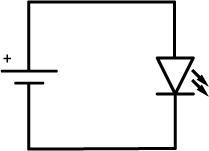Basics of electricity
| Site: | MyCourses |
| Course: | Introduction to Electronics Workshop Space |
| Book: | Basics of electricity |
| Printed by: | Guest user |
| Date: | Thursday, 21 November 2024, 7:28 PM |
Description
What is electricity, how to build simple circuits, reading diagrams and using breadboards.
1. Let's Get Started
Let us start with a very simple exercise that demonstrates some fundamental concepts of electricity:
- Pick up a coin cell battery (CR2016 or CR 2032) and a LED.
- Put the flat sides of the coin cell between the legs of the LED and squeeze so that they make contact.
- Does the light turn on?
- Turn the LED the other way around so the legs connect to the sides in inverse.
- Does the light turn on?
If all went well you should have been able to get the light to light to turn on. Let us deconstruct this, we connected a led to a battery. We describe this kind of connection in a abstract drawing called a schematic as follows:

Image 1: Schematic of the connection you did.
Notice how the loop is closed? It has to be, if it would not then it would be like putting water into a pipe with one end closed. No water would flow once the pipe is full, electrons move at close to speed of light so they fill up anything quite quickly. Simply the electrons have to be free to move about the battery needs to be able to collect the electrons back and lift them to a higher potential. This is why its called a circuit.
The circuit we have made is not really a good one, we are in fact overloading the LED slightly. If the source would be any higher than we would burn the led and heat the battery considerably
A short circuit happens when you connect a wire from battery directly to the ground trough insufficient resistance unintentionally. This causes the system to discharge electricity very quickly over the wire causing it to heat up quickly, sometimes explosively. In fact the circuit we have made is very close to a short circuit
Schematics are important to understand if you ever want to examine or communicate your designs to others. They also guide you on how to connect individual components, although abstractly; The physical line does not have to follow the same path as in your schematic just connect to same end point.
Ok, let us try to build the following